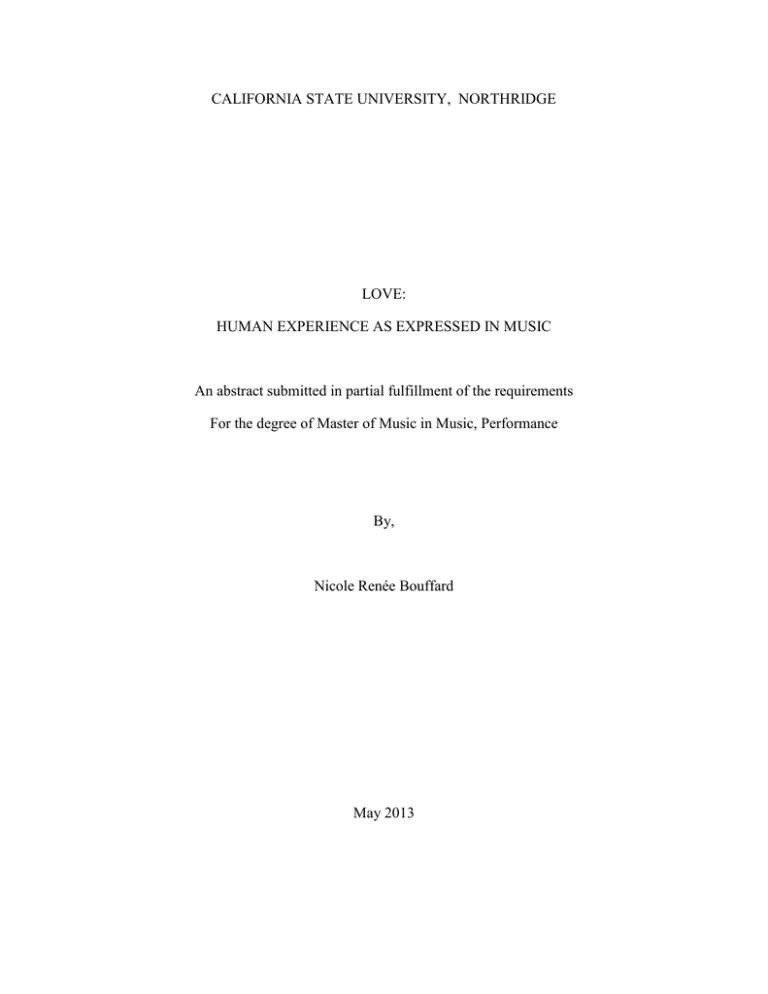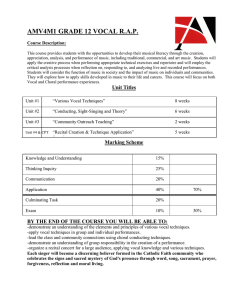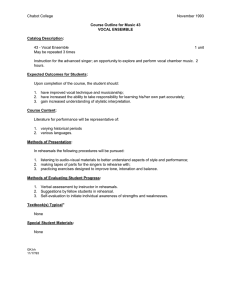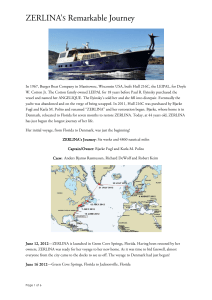CALIFORNIA STATE UNIVERSITY, NORTHRIDGE LOVE: HUMAN EXPERIENCE AS EXPRESSED IN MUSIC
advertisement

CALIFORNIA STATE UNIVERSITY, NORTHRIDGE LOVE: HUMAN EXPERIENCE AS EXPRESSED IN MUSIC An abstract submitted in partial fulfillment of the requirements For the degree of Master of Music in Music, Performance By, Nicole Renée Bouffard May 2013 The abstract of Nicole Renée Bouffard is approved: Dr. Steven Thachuk Date Dr. David Sannerud Date Dr. Deanna Murray, chair Date California State University, Northridge ii Table of Contents Signature Page ii Abstract iv Program vii iii ABSTRACT LOVE: HUMAN EXPERIENCE AS EXPRESSED IN MUSIC by Nicole Renée Bouffard Master of Music in Music, Performance Music is a form of abstract and essential communication between individuals expressing their emotions, thoughts, troubles and blessings in a way that allows the message to be personally and significantly received. Love in music and our individual lives, no matter what the subject, is what drives us to madness, sadness, tears of joy and tears of pain. The sharing of human experience can be boiled down to this essential driving force, and as artists it is what we explore, perform and write about the most. This recital examines various forms of love; sacred love, love lost, the joy of blossoming love, eccentric love, flirtatious love and love disappointed. G.F Handel’s “But Oh, What Art Doth Teach” from the cantata Ode for St. Cecilia, establishes a reflective yet open and creative atmosphere for the recital, stating that the art in the human voice surpasses it’s earthly home to reach out toward the choirs of heaven. “Notes inspiring holy love, Notes that wing their heavenly ways” In this music dedicated to the patron saint of musicians, the text elaborates on the holiness and Godliness of music as an art form. The expansive vocal jumps in the first piece, create a difficult vocal challenge for use as the opening piece in the recital but the context is ideal for setting up the mood for the rest of the program. In the second piece, Handel’s “Eternal Source of Light Divine” accompanied by trumpet, the vocal challenge is to keep a graceful vocal line while including solid dynamics while moving through the high tessitura of the piece. The tessitura rests in the upper passagio of the voice around E5 and F5 and therefore requires ample iv breath support to keep in tune. It is also important for the vocalist to be able to keep enough volume to not be drowned out by the trumpet during the parts where each is playing in harmony. These pieces effectively set the stage for an English speaking audience to examine various forms of love. Margaret Garwood’s Six Japanese Songs are 20th century modern pieces which include accompaniment by clarinet as well as piano. The strength of these pieces lies in the contrast between the often dissonant counterpoint between the voice and the clarinet as they operate on the field of color presented by the piano part. The six pieces range from flickering piano parts representing the flutter of butterfly wings in “Two White Butterflies” to the slow adagio and emptiness surrounding the death theme in “Death Song” and “Snow”. The most musically challenging set of the entire recital, these pieces present the vocalist with demanding lines that include atonal intervals against both the clarinet and piano as well as atypical rhythms. While the pieces are short, they are ethereal and powerful with text inspired from the ancient form of Japanese poetry; Haiku. In these six small pieces, the composer translates the literary quality of the Haiku style into music that is direct and powerful creating an immediate and potent aesthetic. This set of music is an ideal example of music relating the complications of Love, both in loss and longing in short moments with precision and elegance. Moving away from atonality and into pointedly chromatic style, the selections by Richard Strauss evoke strength and power in love. The Strauss set, including the pieces; “Kling!”, “Schlagende Herzen” and “Presentation of the Rose” from Der Rosenkavalier are quite operatic and characterize love in its purest and most idealized form. The vocal lines in these pieces require stamina and strength for the powerful dynamics and message of joyous and celebratory love. With whirlwinds of color in the tonalities and proclamatory statements found in the piano part, a Strauss singer must be able to produce a finessed and powerful sound, full and exciting, as well as delicate and nuanced with variations in color. These pieces bring a mood to the program that celebrates love in its most joyous and youthful form. In Quatre Chanson de Jeunesse by Claude Debussy, the singer must explore the love of life through the many faceted personalities represented in each of these four songs. These songs are published together, but are not a cycle. The whimsical text for these four pieces is taken from the poetry of the famous French poet and writer, Paul Verlaine. Each of the four pieces, Pantomime, Claire de lune, Pierrot and Appartition take a journey through vignettes of daily life in Verlaine’s sometimes somber, sometimes eccentric characters. From eating paté to wondering at the moon, the singer is forced to create these varied worlds within themselves and allow the worlds to be represented through their performance. In these songs, Debussy presents many vocal challenges for the singer. At the end of Pierrot, the singer must be able to trill lightly on A5 with staccato coloratura and bounce down and perform the same facility an octave lower. The tessitura for Quatre Chanson de Jeunesse lies slightly low and at times, often surprising and jaunty, jumps up into the upper passagio for a brief moment and then flies back down into the middle range of the voice. Claire de lune, the most elegant of the pieces is simple and expressive. v These charming songs along with their coloristic accompaniments offer a pinnacle of achievement from Debussy’s early years. In Mozart’s famous duet, “La ci darem la mano” we see a type of love that is far from holy and far from innocent. The characters, Zerlina and Don Giovanni are both participating in a seduction. As Zerlina is getting ready to be married to Masetto, her young, naïve lover; she encounters the calculating Don Giovanni who attempts to seduce her. Zerlina, being young but maybe not so naïve, welcomes the seduction and throughout the opera finds herself in the arms of Giovanni. The soubrette is often played by young and attractive vocalists, but the singer must require a strong middle range to pull off the short tessitura that exists mainly between B3 and G5. The Mozart soubrette roles like Zerlina and even Despina from Cosi fan Tutte must have a voice that carries in the middle range because they have the lowest female vocal line in all group numbers and trios. In the program’s conclusion, the quartet from Rigoletto; “Bella figlia dell’amore,” derives its pathos from four conflicting versions of love. Verdi achieves a musical idiom from the exploration of each of the characters perspective as they interact. Each pair, including the Duke with Maddelena and Gilda with her father, Rigoletto, split a spectrum of love spanning from the warmth of flirtation to the cold reality of lament. As the Duke seduces and flirts with Maddelna, Rigoletto reveals the Duke’s infidelity to Gilda. The conflicting perspectives are musically represented by the rushed and breathless 16th notes in Maddelenas’ line in stark contrast to Gilda’s sighing legato lament which employs carefully placed accidentals to suggest weeping – this being also, the most vocally challenging aspect of the piece for the soprano soloist. The breath required to repeat the line of ascending eighth note steps interrupted by the short eighth rests takes a studies breath support and dedication to the line. It is also important to find appropriate voice matches for the other three parts to flush out the tableau and create the musical scene. The world of art and the existence of humanity revolve around these internal feelings of love and how it transforms in our varied and speckled experience. From the love of the glory of God and the holiness of music itself found in the opening Handel pieces, to the pointed, icy emptiness and loss of love in Garwoods’ Six Japanese Songs, the strength of raw and vital love that Richard Strauss illuminates, to the love of human eccentricity found in Debussy’s Quatre Chanson de Jeunesse and finally to the dark side of Don Giovanni and his love of sensual conquest. Without love there would be no joy, without love there would be no ache, without love one would never bond to another whether the bond is sexual, familial, friendly or otherwise. Without this basic emotion that drives every one of us, there may be nothing to life at all and the artist would have nothing to sing or to write. Love may be easily distinguished and analyzed, but as one examines the different kinds of love through music it becomes apparent that the inspiration for all those inspired, even inspired by differences themselves, come from the basic and universally shared human emotion called; Love. vi vii






